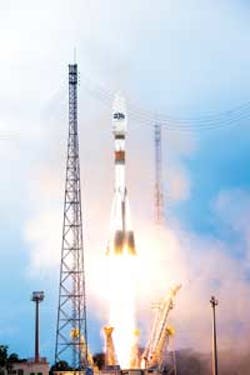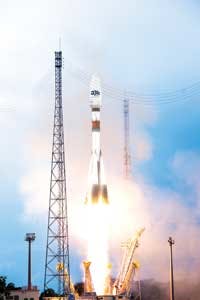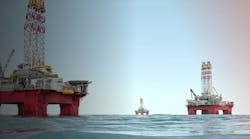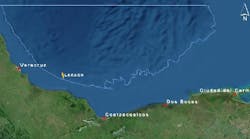Simon Maher
O3b Networks
The modern remote offshore platform is a technological marvel—a small, high-tech city, meticulously designed so every square inch is efficiently used to help achieve the installation's goal. In addition to the array of industrial equipment, a typical installation includes sleeping quarters, offices, recreation centers, a galley, and of course extensive communications systems to support crew productivity and leisure.
But deepwater platforms are forced to deal with the harsh reality of being on a small island far from shore. Data connectivity is excruciatingly slow because of low transfer rates and unresponsive due to extremely high latency. What is the cause of all these problems? The only viable option for a deepwater platform is a geostationary (GEO) satellite connection, which cannot provide the high data throughput and low latency demanded by today's chief information officers and chief technology officers. In short, true broadband has not been available on these platforms—until now.
A new breed of satellite network can now provide connectivity to offshore environments comparable to speeds onshore.
The O3b solution uses medium earth orbit (MEO) satellites, which deliver high throughput and low latency. The throughput on its satellites have been measured up to 1.6 Gigabits/second (the O3bEnergy service can deliver 20 to 100-plus Megabits/second to an offshore platform) providing uplink and downlink data rates necessary for heavy traffic and large file sizes. The ultra-low latency speeds are comparable to long-haul fiber, measuring less than 150 ms round trip. Because MEO satellites orbit at a far lower elevation than a GEO orbit (only 5,000 vs 22,000 mi), signals travelling at the speed of light take less time to make the trip to the satellite and back, so response time is faster.
Latency is the primary issue with offshore installation connectivity, as it affects the majority of applications already in use, requiring workarounds and specialized solutions. The high bandwidth capabilities of a MEO connection support big data, data protection, and centralized IT infrastructure, which enables private and public cloud systems. High throughput and low latency optimizes a company's technology and IT infrastructure in a cost-effective way.
Companies with deepwater and ultra-deepwater platforms are increasingly asking their IT personnel to deploy and support systems that require large amounts of data, high traffic volumes, and low latency to function properly. And they are asked to do this while keeping everything within budget.
Cloud-based applications such as Citrix, Sharepoint, SAP, and other database-driven enterprise resource planning and customer relationship management applications are extremely important to the offshore environment, but each are extremely latency-sensitive. High latency makes use of these productivity systems frustrating at best, and in many cases simply impossible. Offshore users report experiencing Citrix page load times of 30-60 seconds with their current GEO connection. With the cost/hour to run an offshore installation, those slow load times are directly eating into the profitability of the platform. Changing over to a MEO connection instantly enables full use of cloud-based applications, allowing deepwater staff to increase productivity.
Big Data—high volumes of varying data needing to be transferred at high speeds—generated from sensors measuring business-critical variables such as pressure and machinery health are stressing deepwater platform IT infrastructures. The low latency, high throughput combination of a MEO solution supports interactive applications and helps companies produce and monitor large amounts of data in real-time. The seismic information collated is invaluable for both productivity as well as safety, but can be massive and difficult to move for analysis once collected without a MEO or fiber connection.
Companies wishing to centralize monitoring and control require highly interactive applications that rely on advanced communications. Innovations in drill sensors and tools for deepwater platforms allow more remote monitoring and control, and all rely on low latency so staff can observe in real time. So long as the connection can be relied upon, the latency is low, and the throughput is high enough to transmit necessary data, oil and gas companies can centralize their monitoring operation architectures, and free up valuable space on the platform for more productive use.
Connection reliability is another vital factor for any offshore installation. There is a high cost associated with communications failures, as unproductive assets and highly paid staff unable to carry on with their work results in a revenue loss of thousands of dollars per hour. Underwater cables are vulnerable to damage by natural events or malicious acts, whereas a satellite constellation such as O3b's is stable and provides redundancy to ensure uninterrupted service. The MEO satellites in the company's network already have a proven track record of reliability, with customers worldwide now fully depending on the system to provide high-quality connectivity under all conditions.
Skilled, experienced employees in deepwater drilling and production are not only expensive but also in short supply, so crew welfare and retention should not be ignored. With the typical stay on a platform between 14 and 28 days, allowing crew more of the comforts they have come to expect while onshore should not be underestimated. Real-time gaming, watching online movies, and video calls back home all greatly increase crew satisfaction.
Satellite communication is a proven, reliable technology. And when combined with lower orbits and powerful high throughput spot beams, it is an ideal connectivity option for the offshore market delivering high throughput, low latency, and high reliability. O3b has already proven the success of its own MEO network in various landlocked countries, isolated islands, and even to cruise ships in partnership with Royal Caribbean.
With the ever accelerating reliance on data and connectivity in all aspects of the industry, a high throughput, low latency architecture of a MEO satellite network is becoming more necessary. File sizes will only get larger, mandates to centralize and increase efficiency will rise, and crew demands will only grow.
With additional bandwidth capabilities available, innovations can be unleashed by industry leaders ready to use true broadband connectivity on their deepwater platforms to gain a competitive advantage, and take oil and gas exploration to the next level.






